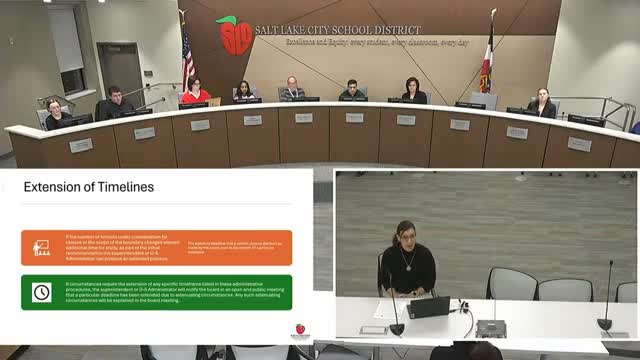School board reviews seismic changes to building closure policies for improved transparency
February 08, 2025 | Salt Lake School District , Utah School Boards, Utah
This article was created by AI summarizing key points discussed. AI makes mistakes, so for full details and context, please refer to the video of the full meeting. Please report any errors so we can fix them. Report an error »

In a recent Salt Lake City School District Board meeting, members engaged in a thoughtful discussion about the process of school closures and boundary changes, emphasizing transparency and community input. The meeting, held on February 4, 2025, highlighted the district's commitment to involving parents and the public in decisions that significantly impact local schools.
Board members acknowledged that while state law does not mandate a formal process for grade level reconfigurations, the district aims to be more transparent than neighboring districts. Instead of simply notifying parents through letters, the board plans to hold public comment periods to gather community feedback before making any decisions. This approach is intended to ensure that the voices of parents and community members are heard, particularly as the district navigates potential school closures.
A key point of discussion centered around the criteria for closing older buildings. Board members recognized that age alone should not determine a building's fate. They noted that some older schools might be critical to the community due to their geographical location or other unique factors. This nuanced perspective aims to prevent hasty decisions based solely on a building's age, as past experiences showed that some older buildings remained open while newer ones were closed due to their strategic importance.
The policy subcommittee, which spent considerable time reviewing survey results and discussing potential changes, presented recommendations aimed at refining the closure process. While no immediate action was taken during the meeting, board members expressed a desire to move forward with the proposed changes, ensuring that the process is clear and minimizes disruption for families and staff.
Concerns were raised about the timing of closure decisions, particularly the impact on teachers and families. Board member Amanda emphasized the need for clear communication and adequate time for adjustment, suggesting that if decisions are made later in the school year, they should apply to the following academic year rather than the immediate one. This would allow for a smoother transition for all involved.
As the meeting concluded, the board members left with a sense of purpose, committed to refining their processes and ensuring that community input remains at the forefront of their decision-making. The discussions reflect a broader commitment to fostering a collaborative environment as the district navigates the complexities of school closures and boundary adjustments in the years to come.
Board members acknowledged that while state law does not mandate a formal process for grade level reconfigurations, the district aims to be more transparent than neighboring districts. Instead of simply notifying parents through letters, the board plans to hold public comment periods to gather community feedback before making any decisions. This approach is intended to ensure that the voices of parents and community members are heard, particularly as the district navigates potential school closures.
A key point of discussion centered around the criteria for closing older buildings. Board members recognized that age alone should not determine a building's fate. They noted that some older schools might be critical to the community due to their geographical location or other unique factors. This nuanced perspective aims to prevent hasty decisions based solely on a building's age, as past experiences showed that some older buildings remained open while newer ones were closed due to their strategic importance.
The policy subcommittee, which spent considerable time reviewing survey results and discussing potential changes, presented recommendations aimed at refining the closure process. While no immediate action was taken during the meeting, board members expressed a desire to move forward with the proposed changes, ensuring that the process is clear and minimizes disruption for families and staff.
Concerns were raised about the timing of closure decisions, particularly the impact on teachers and families. Board member Amanda emphasized the need for clear communication and adequate time for adjustment, suggesting that if decisions are made later in the school year, they should apply to the following academic year rather than the immediate one. This would allow for a smoother transition for all involved.
As the meeting concluded, the board members left with a sense of purpose, committed to refining their processes and ensuring that community input remains at the forefront of their decision-making. The discussions reflect a broader commitment to fostering a collaborative environment as the district navigates the complexities of school closures and boundary adjustments in the years to come.
View full meeting
This article is based on a recent meeting—watch the full video and explore the complete transcript for deeper insights into the discussion.
View full meeting

